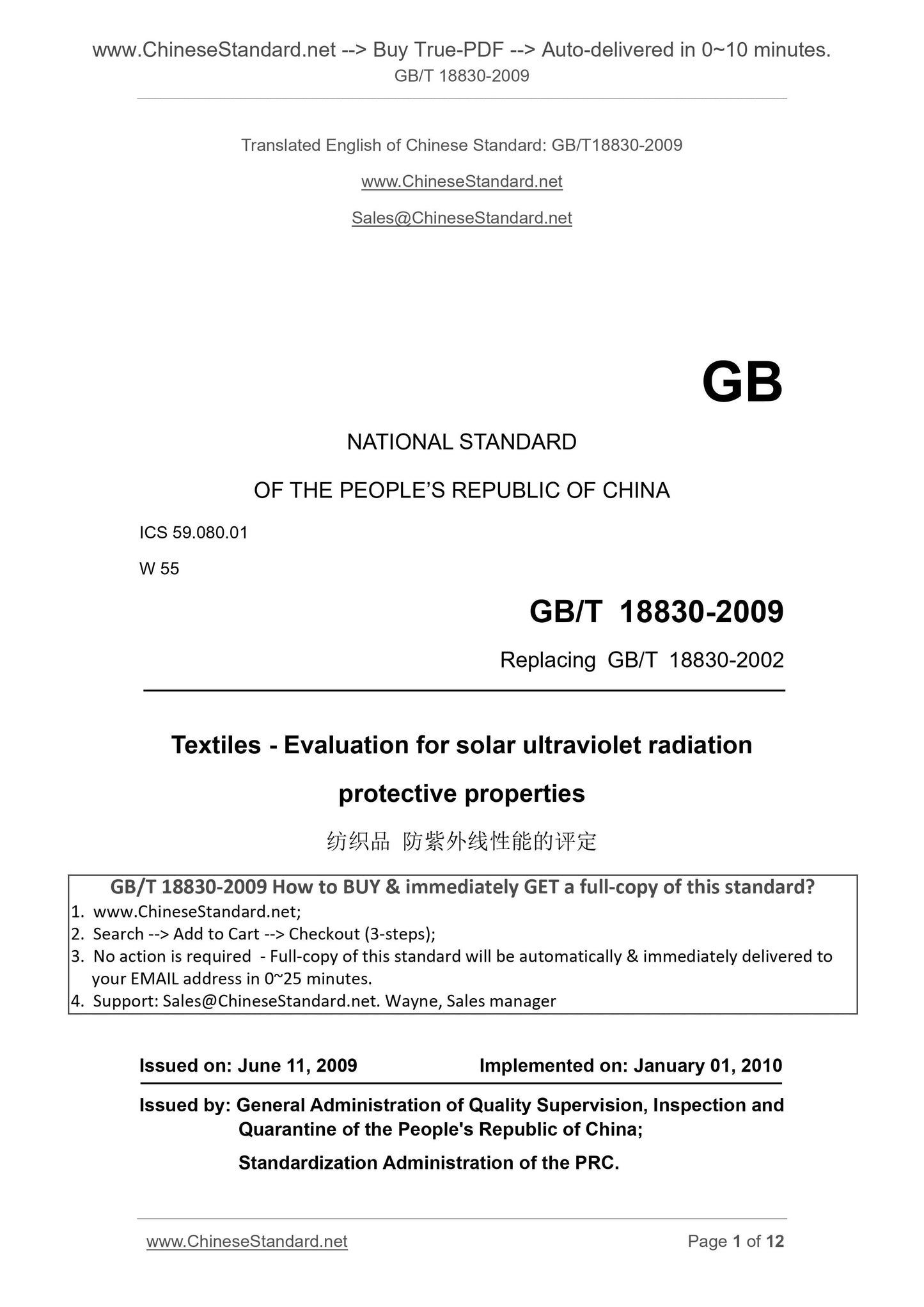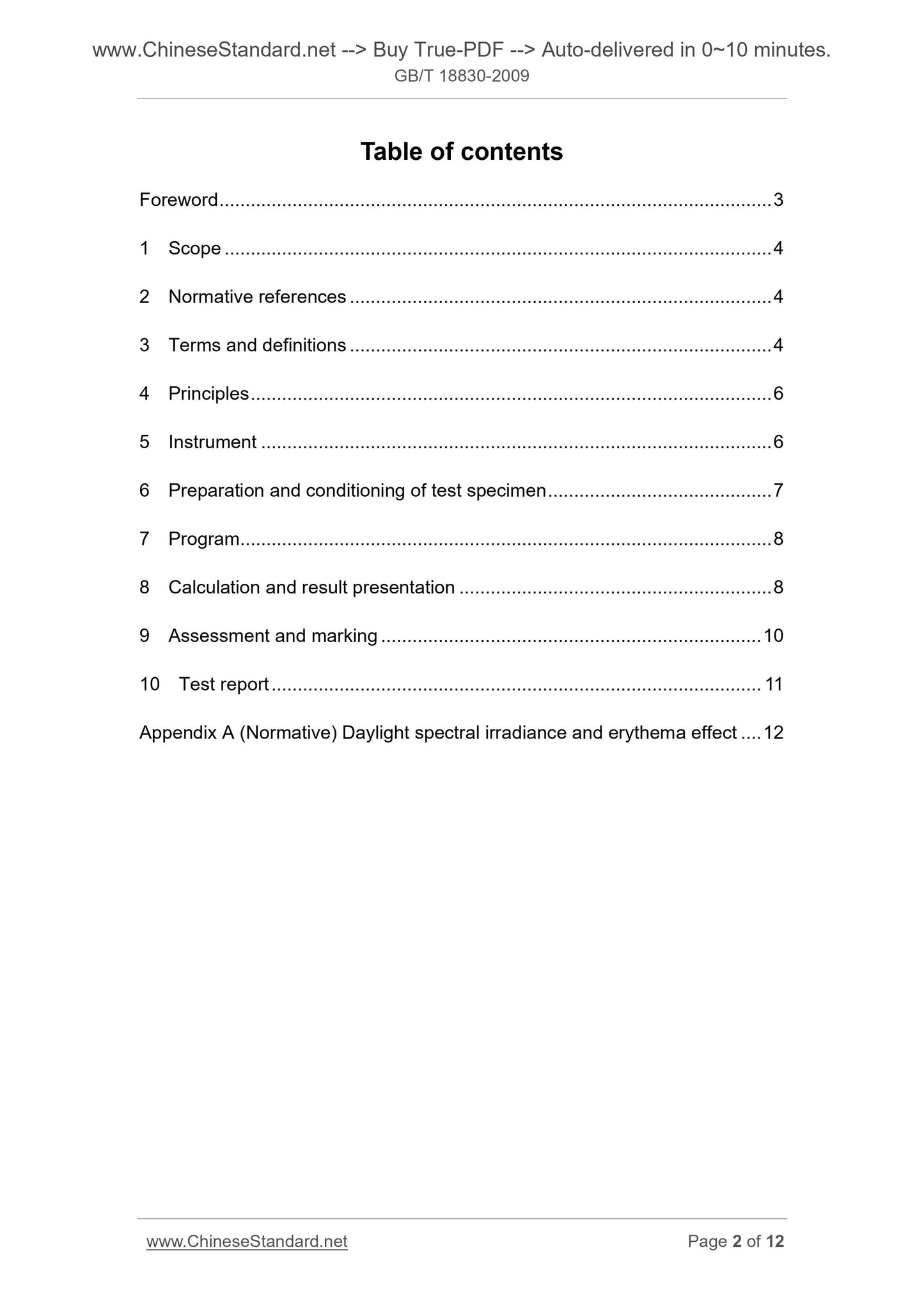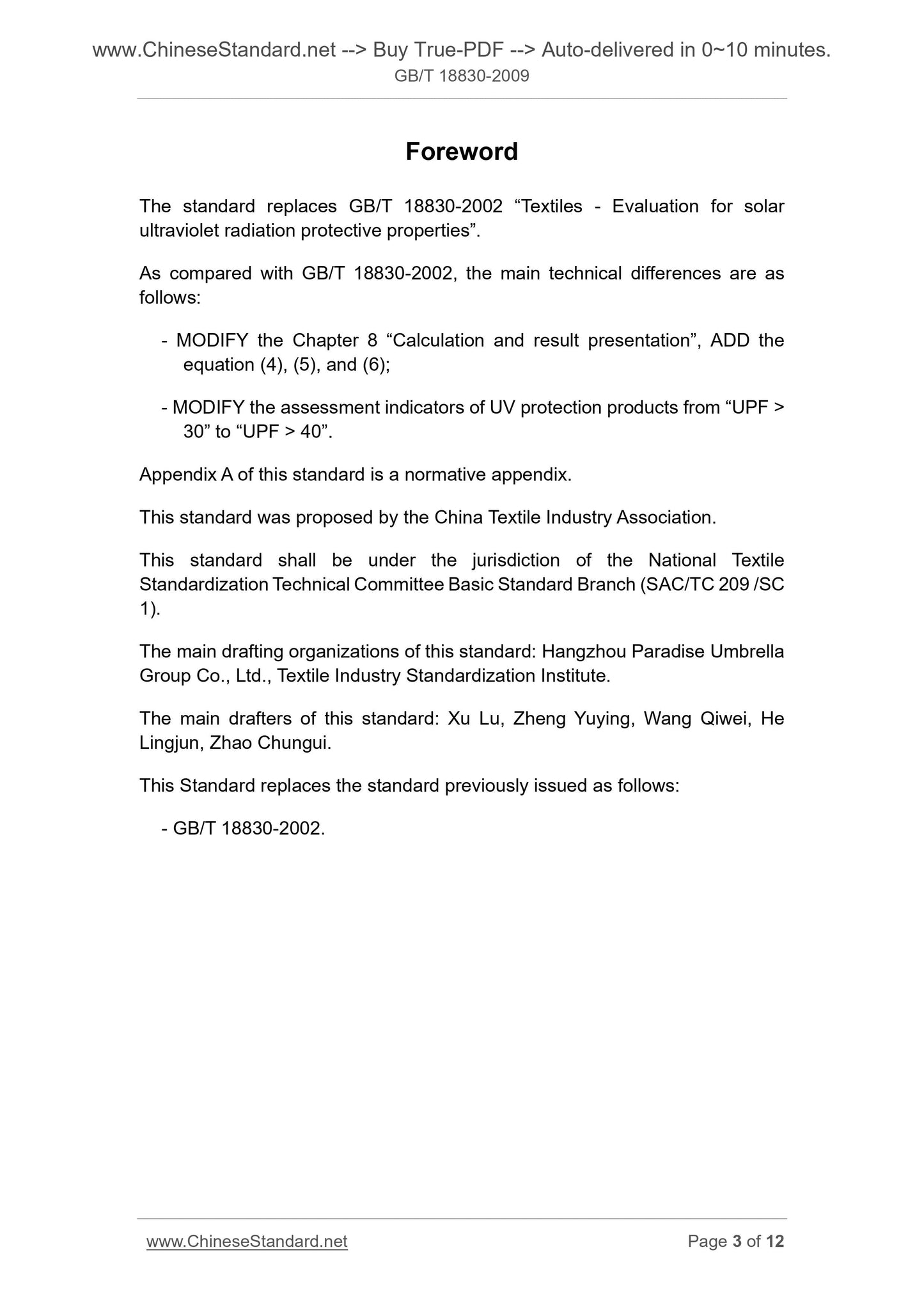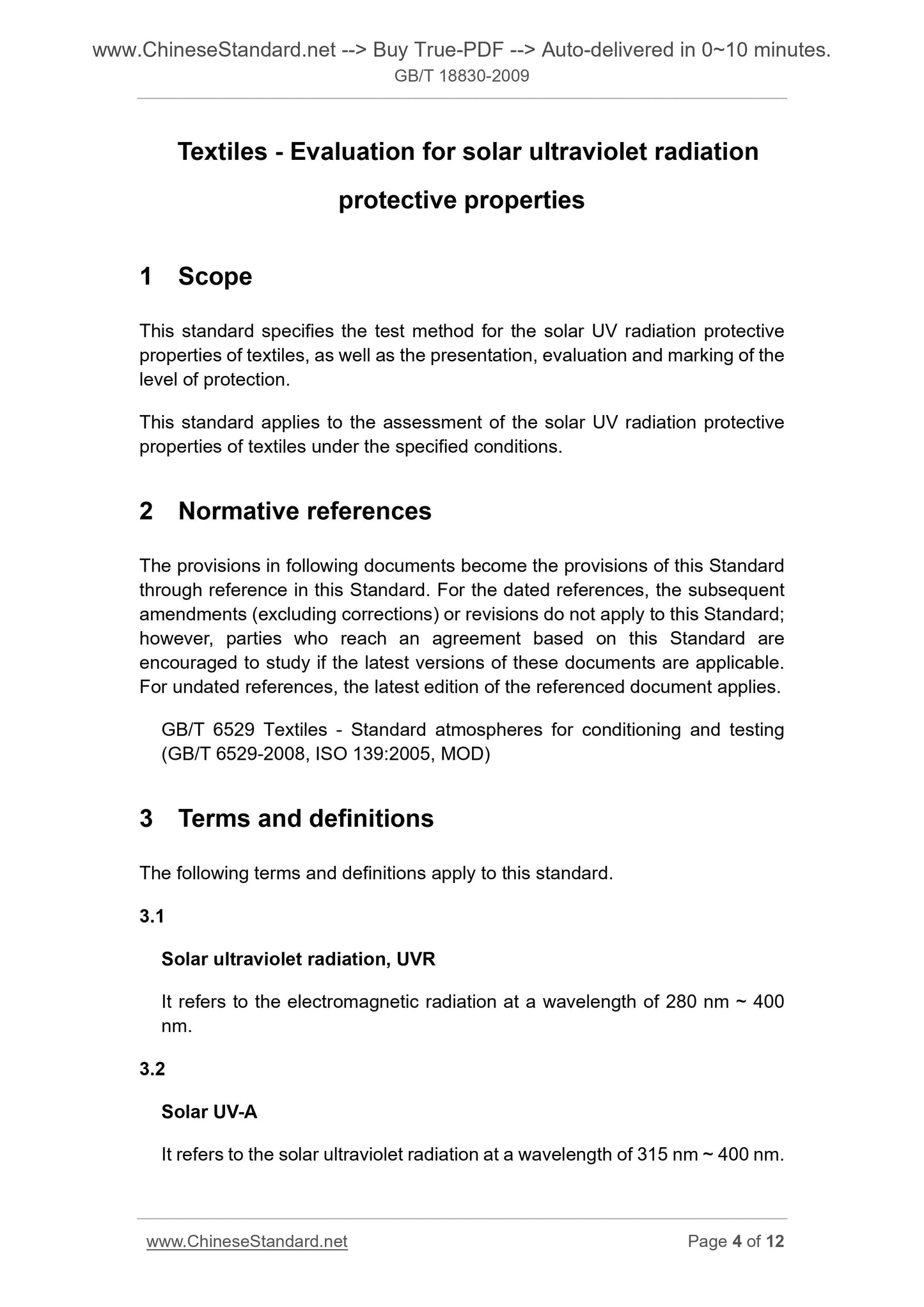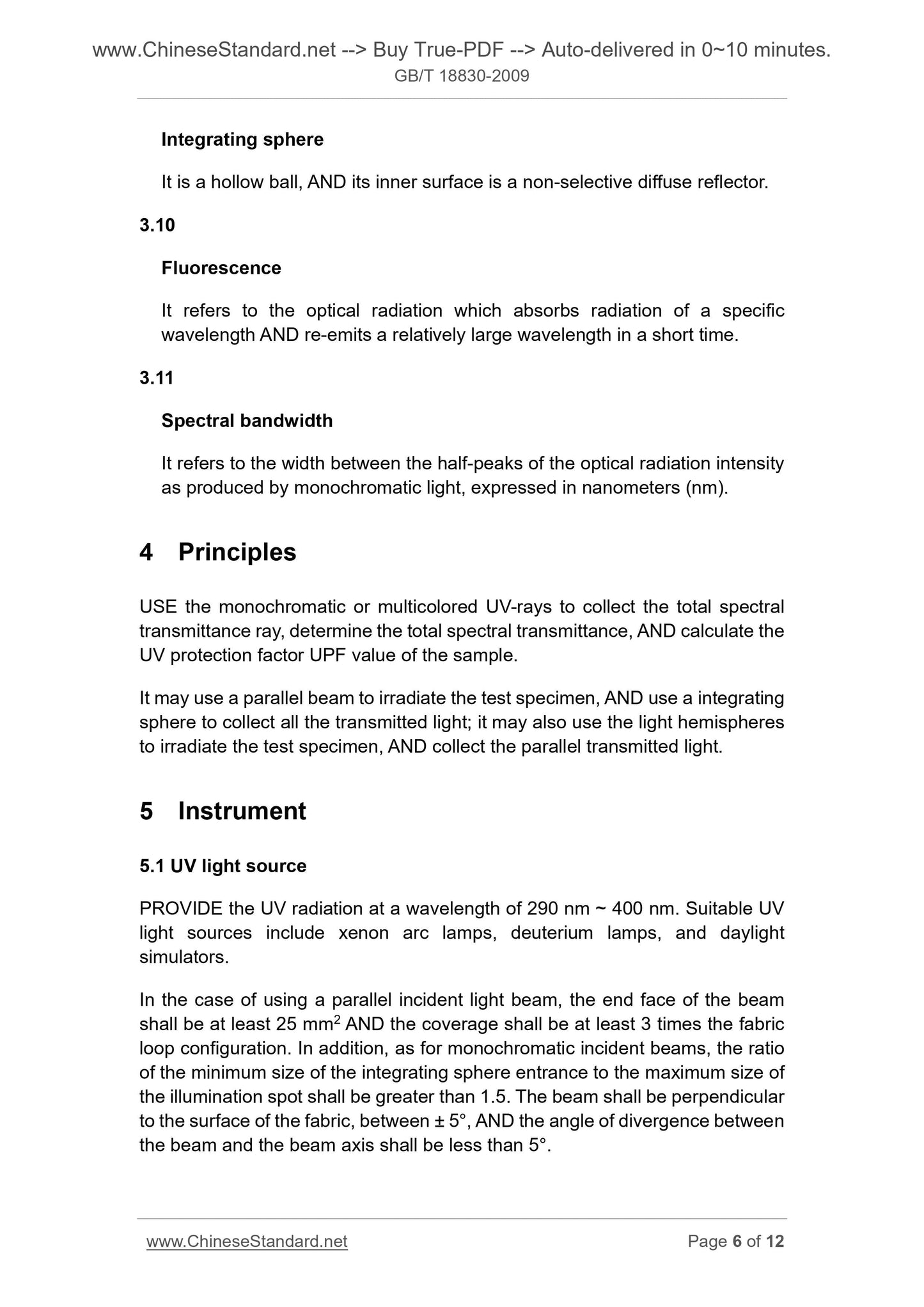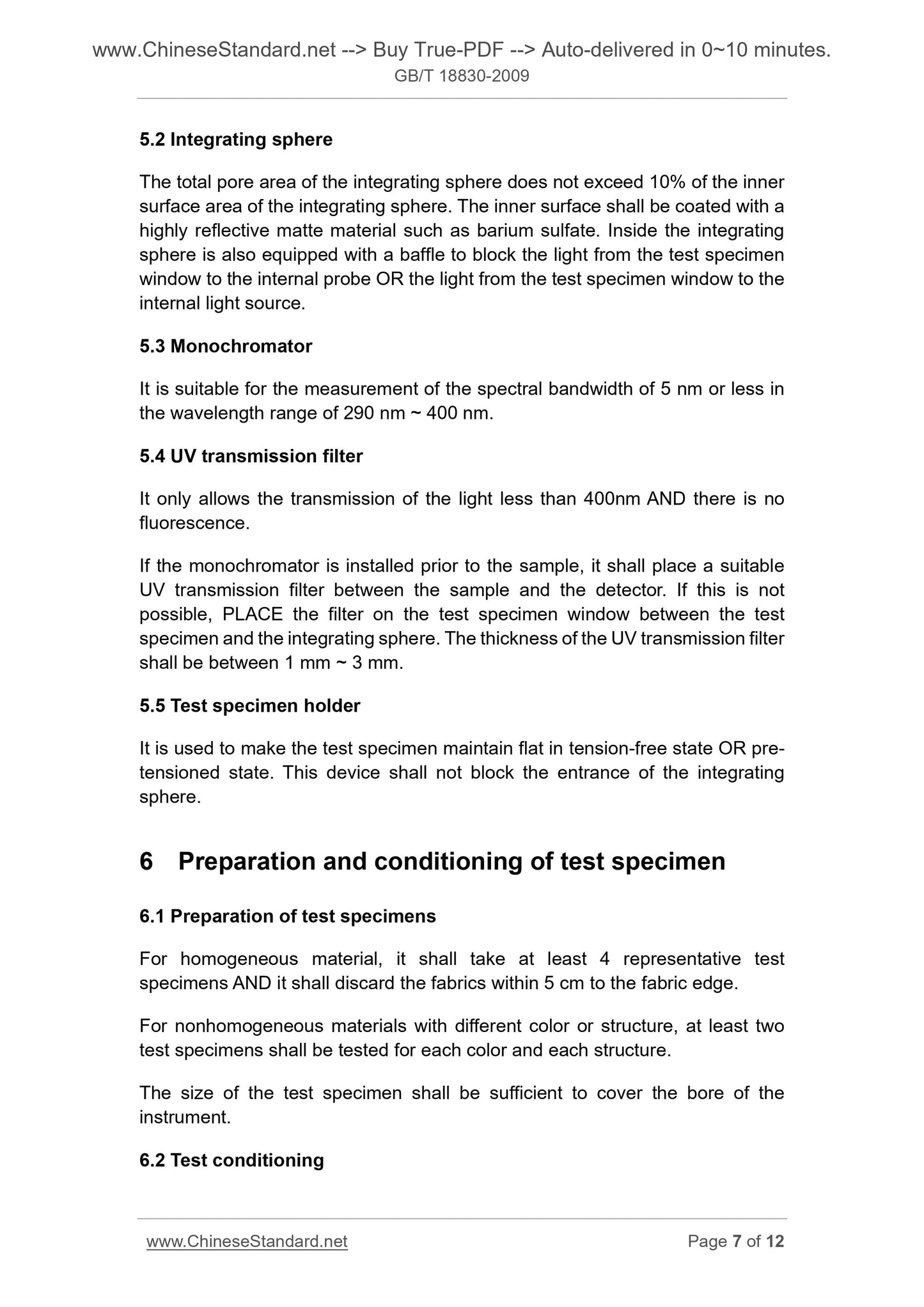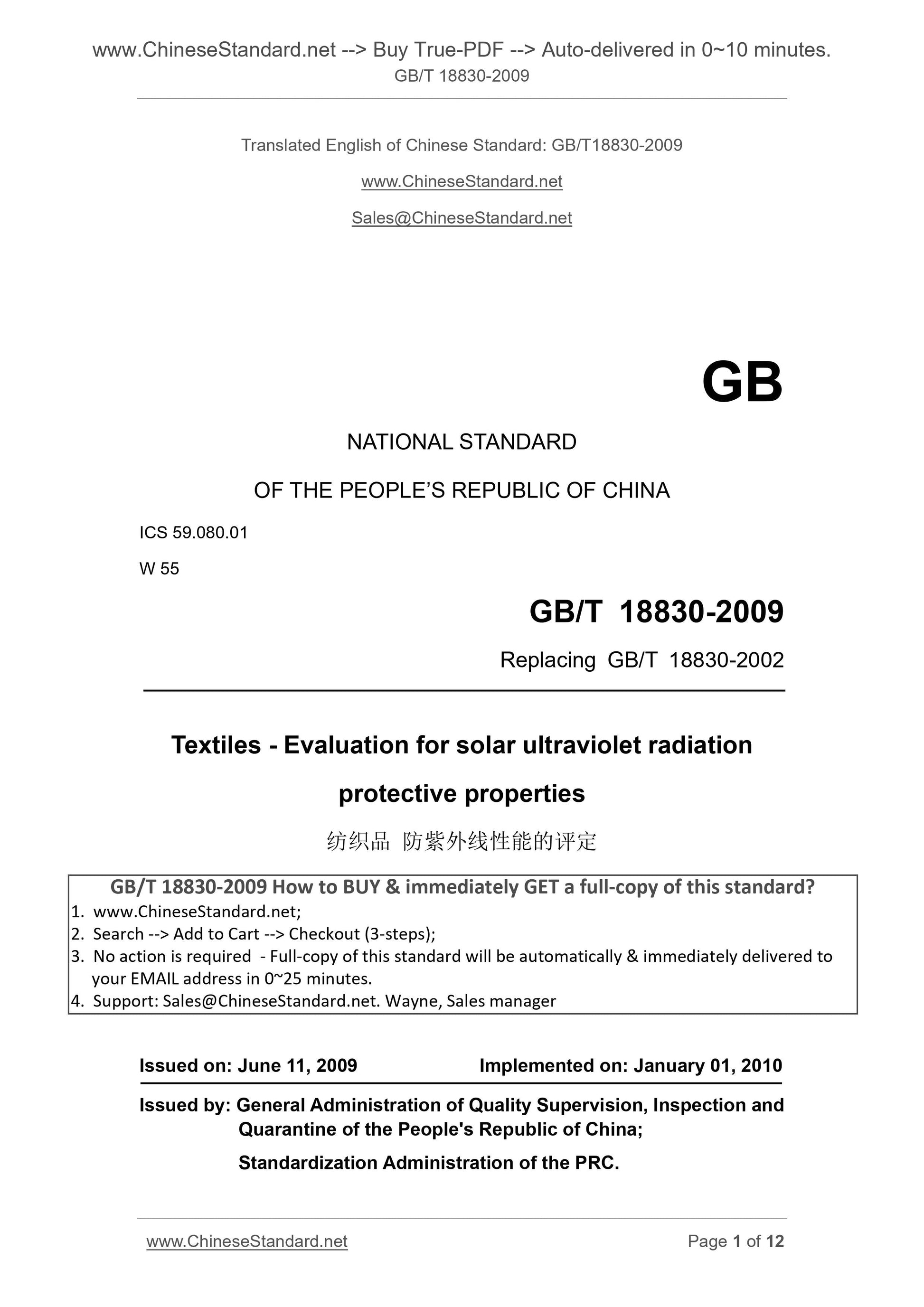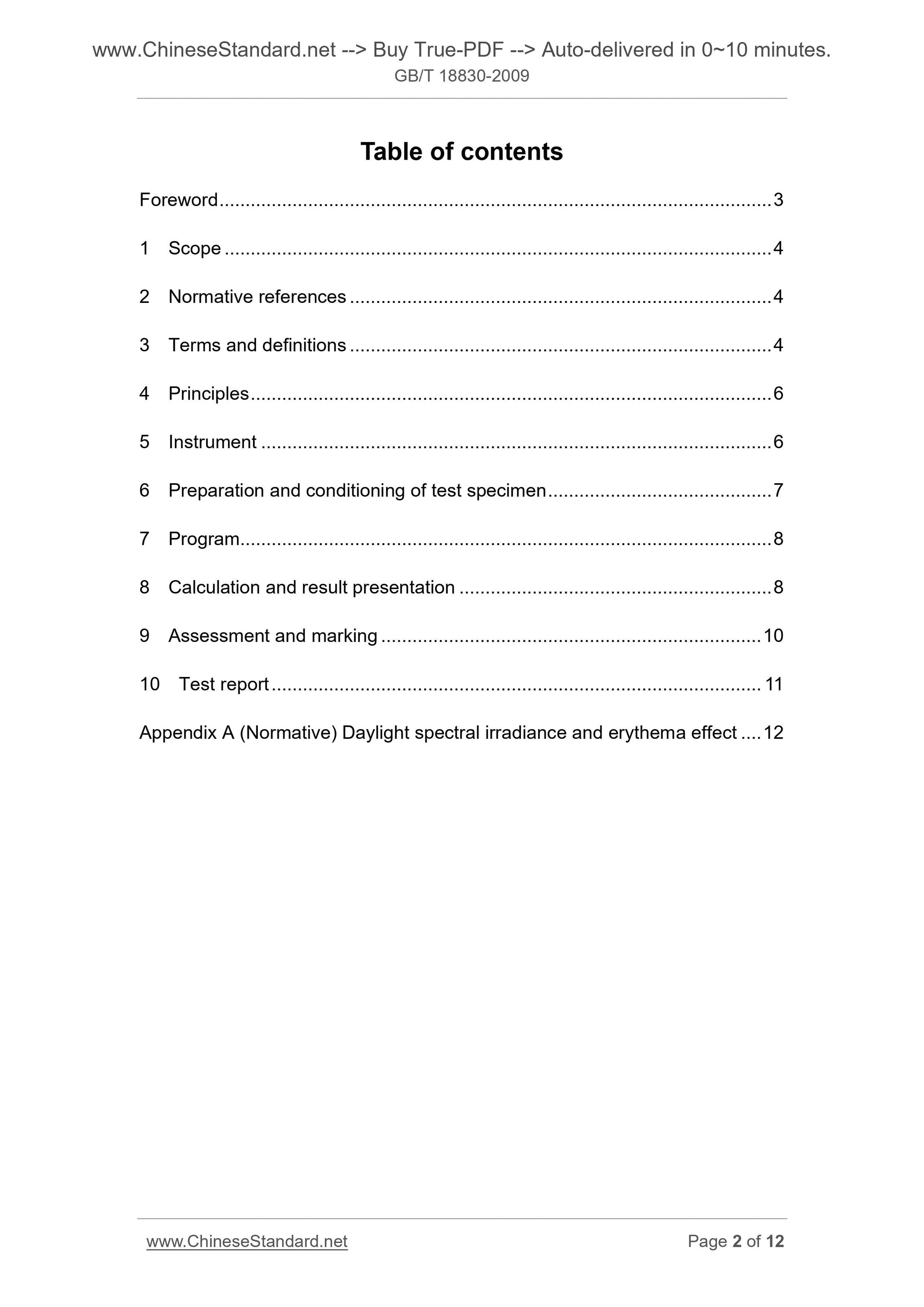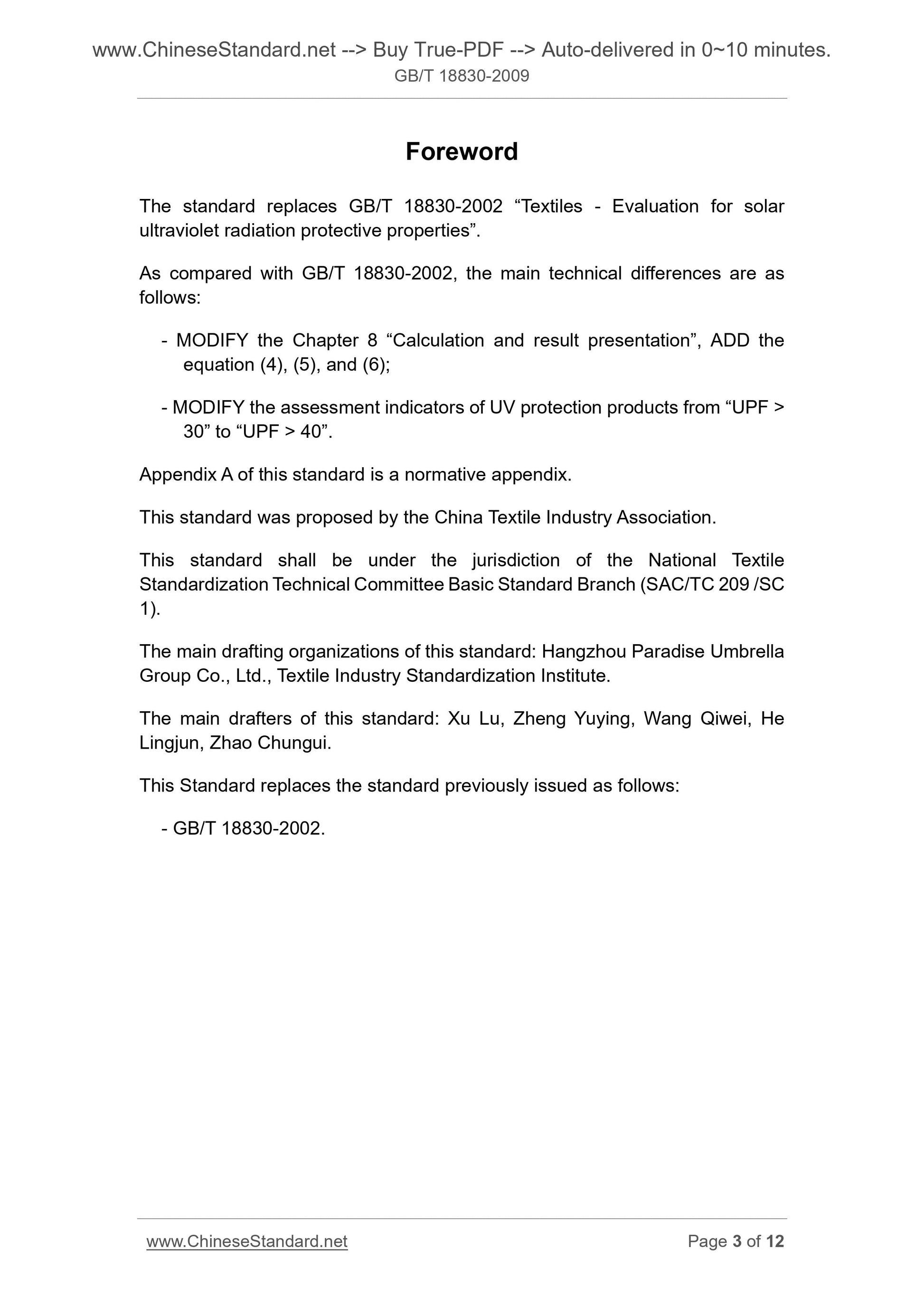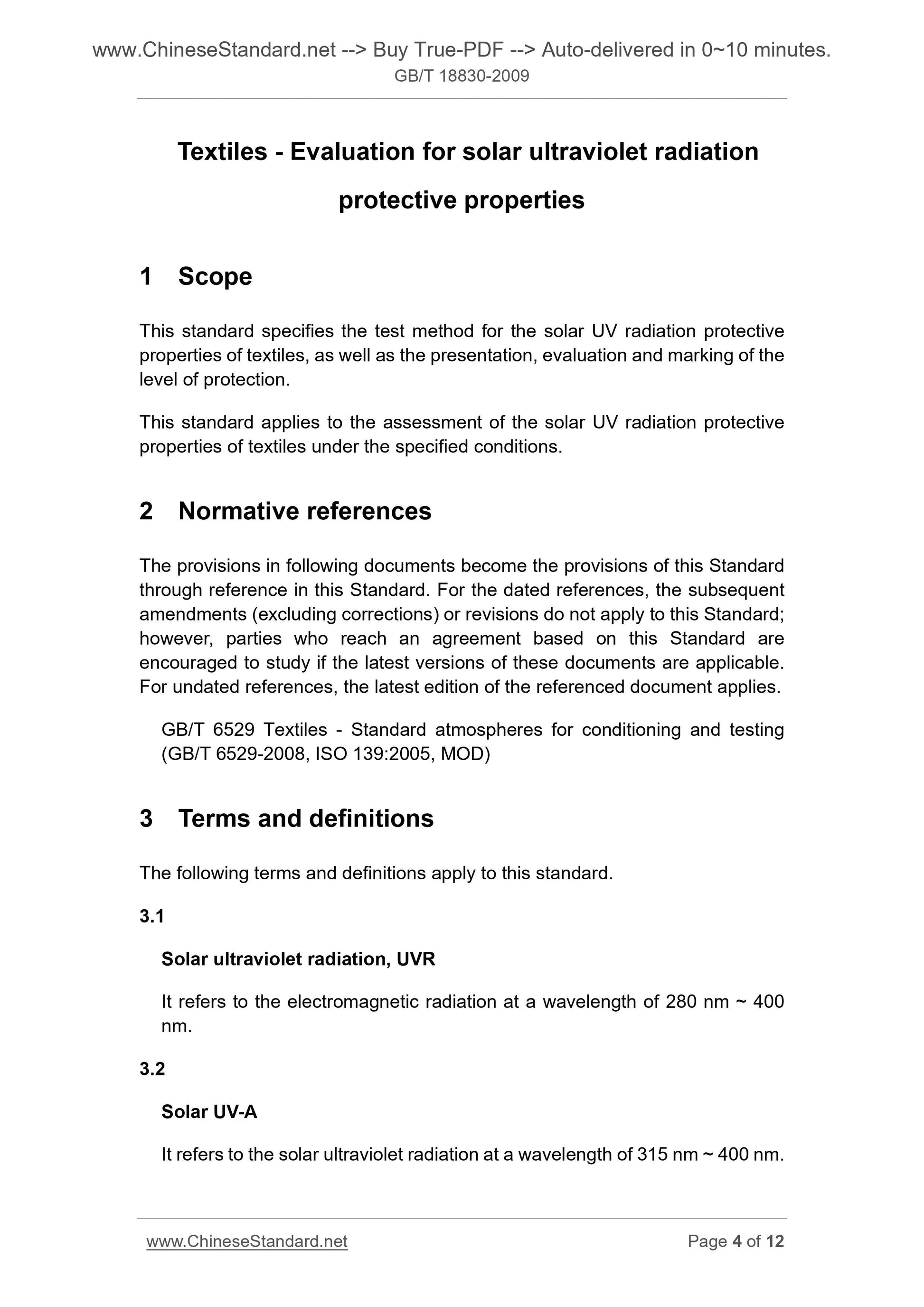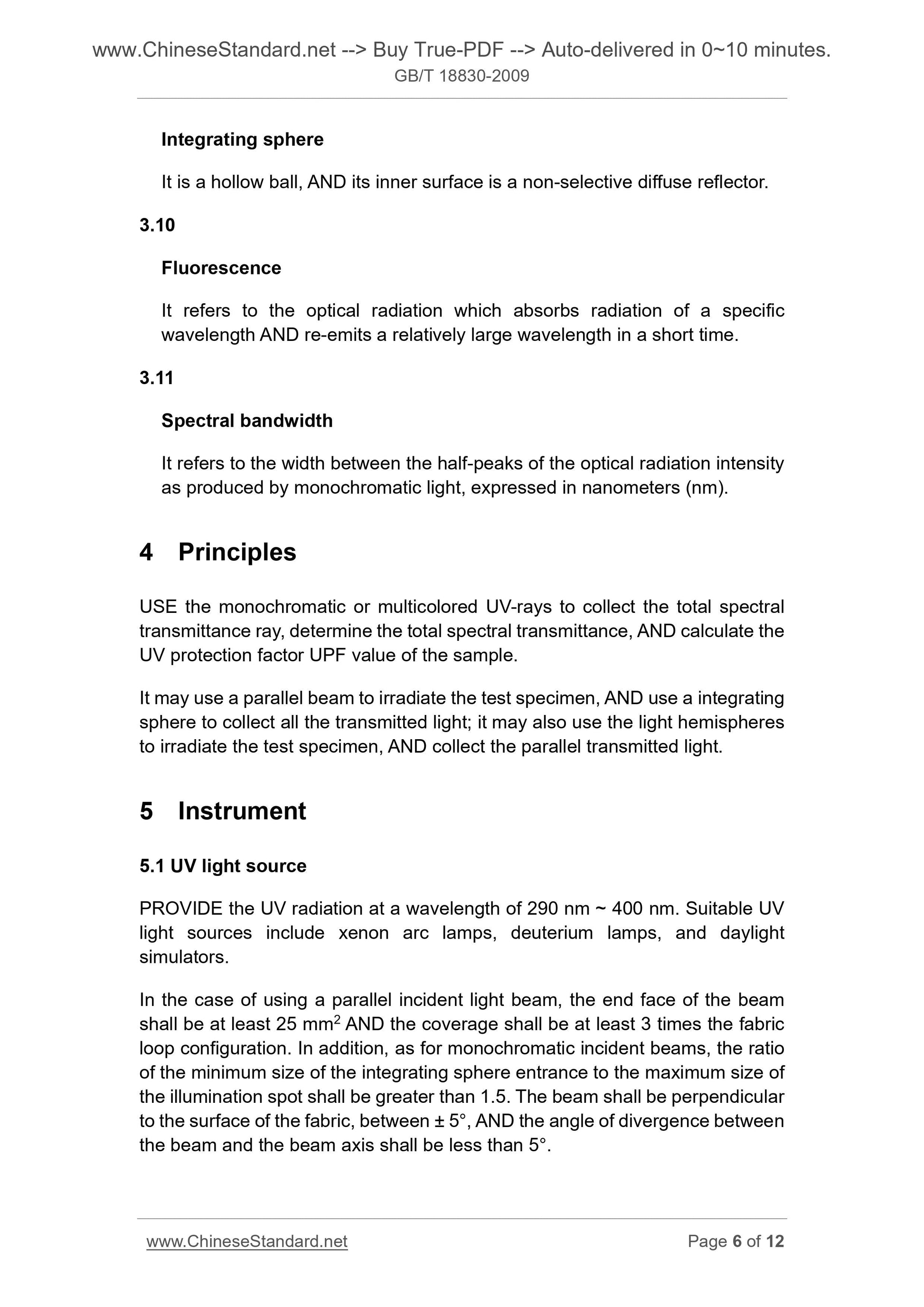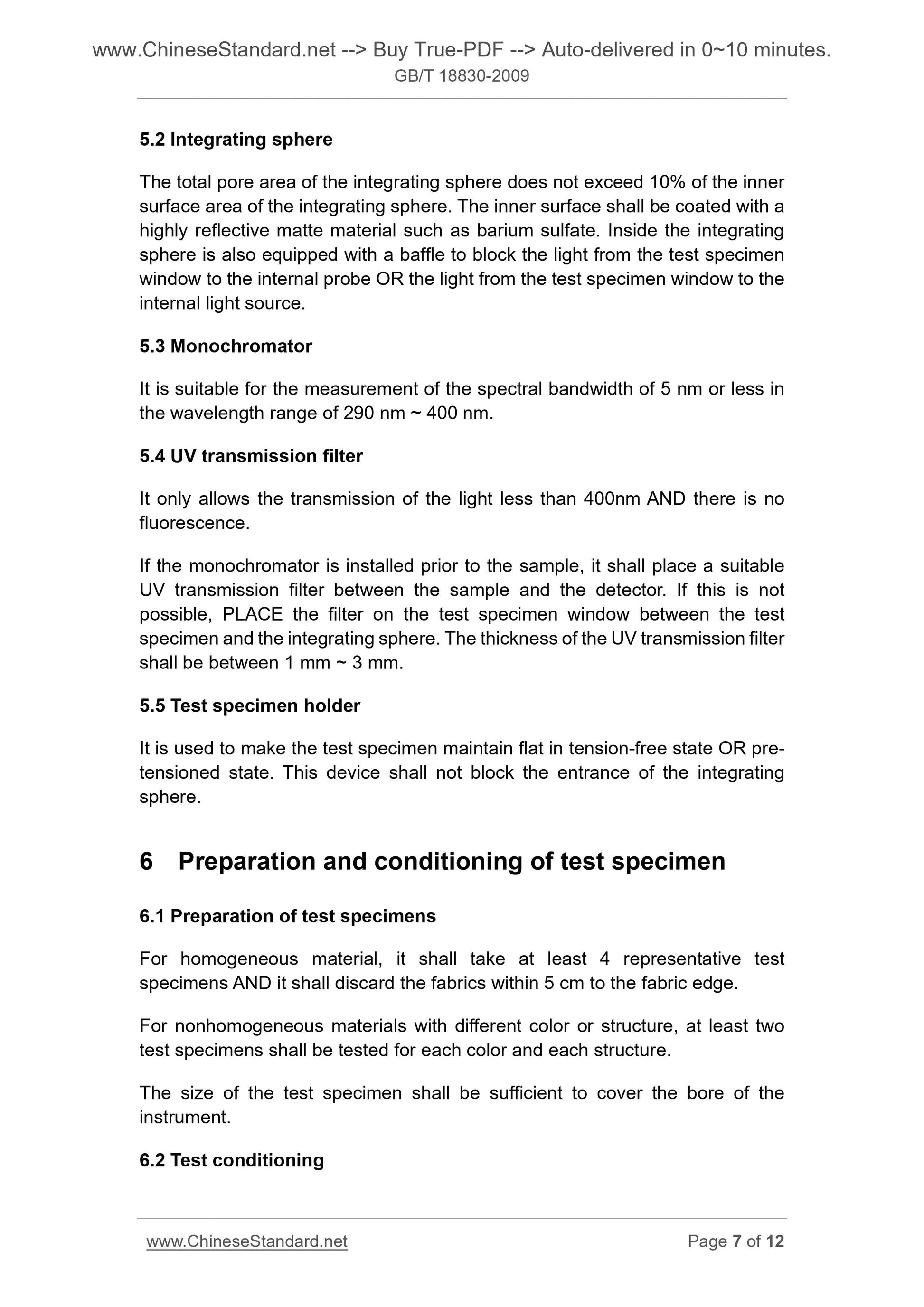1
/
of
6
PayPal, credit cards. Download editable-PDF and invoice in 1 second!
GB/T 18830-2009 English PDF (GBT18830-2009)
GB/T 18830-2009 English PDF (GBT18830-2009)
Regular price
$70.00 USD
Regular price
Sale price
$70.00 USD
Unit price
/
per
Shipping calculated at checkout.
Couldn't load pickup availability
Delivery: 3 seconds. Download true-PDF + Invoice.
Get QUOTATION in 1-minute: Click GB/T 18830-2009
Historical versions: GB/T 18830-2009
Preview True-PDF (Reload/Scroll if blank)
GB/T 18830-2009: Textiles -- Evaluation for solar ultraviolet radiation protective properties
GB/T 18830-2009
GB
NATIONAL STANDARD
OF THE PEOPLE’S REPUBLIC OF CHINA
ICS 59.080.01
W 55
Replacing GB/T 18830-2002
Textiles - Evaluation for solar ultraviolet radiation
protective properties
ISSUED ON. JUNE 11, 2009
IMPLEMENTED ON. JANUARY 01, 2010
Issued by. General Administration of Quality Supervision, Inspection and
Quarantine of the People's Republic of China;
Standardization Administration of the PRC.
Table of contents
Foreword ... 3
1 Scope ... 4
2 Normative references ... 4
3 Terms and definitions ... 4
4 Principles ... 6
5 Instrument ... 6
6 Preparation and conditioning of test specimen ... 7
7 Program... 8
8 Calculation and result presentation ... 8
9 Assessment and marking ... 10
10 Test report ... 11
Appendix A (Normative) Daylight spectral irradiance and erythema effect ... 12
Foreword
The standard replaces GB/T 18830-2002 “Textiles - Evaluation for solar
ultraviolet radiation protective properties”.
As compared with GB/T 18830-2002, the main technical differences are as
follows.
- MODIFY the Chapter 8 “Calculation and result presentation”, ADD the
equation (4), (5), and (6);
- MODIFY the assessment indicators of UV protection products from “UPF >
30” to “UPF > 40”.
Appendix A of this standard is a normative appendix.
This standard was proposed by the China Textile Industry Association.
This standard shall be under the jurisdiction of the National Textile
Standardization Technical Committee Basic Standard Branch (SAC/TC 209 /SC
1).
The main drafting organizations of this standard. Hangzhou Paradise Umbrella
Group Co., Ltd., Textile Industry Standardization Institute.
The main drafters of this standard. Xu Lu, Zheng Yuying, Wang Qiwei, He
Lingjun, Zhao Chungui.
This Standard replaces the standard previously issued as follows.
- GB/T 18830-2002.
Textiles - Evaluation for solar ultraviolet radiation
protective properties
1 Scope
This standard specifies the test method for the solar UV radiation protective
properties of textiles, as well as the presentation, evaluation and marking of the
level of protection.
This standard applies to the assessment of the solar UV radiation protective
properties of textiles under the specified conditions.
2 Normative references
The provisions in following documents become the provisions of this Standard
through reference in this Standard. For the dated references, the subsequent
amendments (excluding corrections) or revisions do not apply to this Standard;
however, parties who reach an agreement based on this Standard are
encouraged to study if the latest versions of these documents are applicable.
For undated references, the latest edition of the referenced document applies.
GB/T 6529 Textiles - Standard atmospheres for conditioning and testing
(GB/T 6529-2008, ISO 139.2005, MOD)
3 Terms and definitions
The following terms and definitions apply to this standard.
3.1
Solar ultraviolet radiation, UVR
It refers to the electromagnetic radiation at a wavelength of 280 nm ~ 400
nm.
3.2
Solar UV-A
It refers to the solar ultraviolet radiation at a wavelength of 315 nm ~ 400 nm.
Integrating sphere
It is a hollow ball, AND its inner surface is a non-selective diffuse reflector.
3.10
Fluorescence
It refers to the optical radiation which absorbs radiation of a specific
wavelength AND re-emits a relatively large wavelength in a short time.
3.11
Spectral bandwidth
It refers to the width between the half-peaks of the optical radiation intensity
as produced by monochromatic light, expressed in nanometers (nm).
4 Principles
USE the monochromatic or multicolored UV-rays to collect the total spectral
transmittance ray, determine the total spectral transmittance, AND calculate the
UV protection factor UPF value of the sample.
It may use a parallel beam to irradiate the test specimen, AND use a integrating
sphere to collect all the transmitted light; it may also use the light hemispheres
to irradiate the test specimen, AND collect the parallel transmitted light.
5 Instrument
5.1 UV light source
PROVIDE the UV radiation at a wavelength of 290 nm ~ 400 nm. Suitable UV
light sources include xenon arc lamps, deuterium lamps, and daylight
simulators.
In the case of using a parallel incident light beam, the end face of the beam
shall be at least 25 mm2 AND the coverage shall be at least 3 times the fabric
loop configuration. In addition, as for monochromatic incident beams, the ratio
of the minimum size of the integrating sphere entrance to the maximum size of
the illumination spot shall be greater than 1.5. The beam shall be perpendicular
to the surface of the fabric, between ± 5°, AND the angle of divergence between
the beam and the beam axis shall be less than 5°.
5.2 Integrating sphere
The total pore area of the integrating sphere does not exceed 10% of the inner
surface area of the integrating sphere. The inner surface shall be coated with a
highly reflective matte material such as barium sulfate. Inside the integrating
sphere is also equipped with a baffle to block the light from the test specimen
window to the internal probe OR the light from the test specimen window to the
internal light source.
5.3 Monochromator
It is suitable for the measurement of the spectral bandwidth of 5 nm or less in
the wavelength range of 290 nm ~ 400 nm.
5.4 UV transmission filter
It only allows the transmission of the light less than 400nm AND there is no
fluorescence.
If the monochromator is installed prior to the sample, it shall place a suitable
UV transmission filter between the sample and the detector. If this is not
possible, PLACE the filter on the test specimen window between the test
specimen and the integrating sphere. The thickness of the UV transmission filter
shall be between 1 mm ~ 3 mm.
5.5 Test specimen holder
It is used to make the test specimen maintain flat in tension-free state OR pre-
tensioned state. This device shall not block the entrance of the integrating
sphere.
6 Preparation and conditioning of test specimen
6.1 Preparation of test specimens
For homogeneous material, it shall take at least 4 representative test
specimens AND it shall discard the fabrics within 5 cm to the fabric edge.
For nonhomogeneous materials with different color or structure, at least two
test specimens shall be tested for each color and each structure.
The size of the test specimen shall be sufficient to cover the bore of the
instrument.
6.2 Test conditioning
Get QUOTATION in 1-minute: Click GB/T 18830-2009
Historical versions: GB/T 18830-2009
Preview True-PDF (Reload/Scroll if blank)
GB/T 18830-2009: Textiles -- Evaluation for solar ultraviolet radiation protective properties
GB/T 18830-2009
GB
NATIONAL STANDARD
OF THE PEOPLE’S REPUBLIC OF CHINA
ICS 59.080.01
W 55
Replacing GB/T 18830-2002
Textiles - Evaluation for solar ultraviolet radiation
protective properties
ISSUED ON. JUNE 11, 2009
IMPLEMENTED ON. JANUARY 01, 2010
Issued by. General Administration of Quality Supervision, Inspection and
Quarantine of the People's Republic of China;
Standardization Administration of the PRC.
Table of contents
Foreword ... 3
1 Scope ... 4
2 Normative references ... 4
3 Terms and definitions ... 4
4 Principles ... 6
5 Instrument ... 6
6 Preparation and conditioning of test specimen ... 7
7 Program... 8
8 Calculation and result presentation ... 8
9 Assessment and marking ... 10
10 Test report ... 11
Appendix A (Normative) Daylight spectral irradiance and erythema effect ... 12
Foreword
The standard replaces GB/T 18830-2002 “Textiles - Evaluation for solar
ultraviolet radiation protective properties”.
As compared with GB/T 18830-2002, the main technical differences are as
follows.
- MODIFY the Chapter 8 “Calculation and result presentation”, ADD the
equation (4), (5), and (6);
- MODIFY the assessment indicators of UV protection products from “UPF >
30” to “UPF > 40”.
Appendix A of this standard is a normative appendix.
This standard was proposed by the China Textile Industry Association.
This standard shall be under the jurisdiction of the National Textile
Standardization Technical Committee Basic Standard Branch (SAC/TC 209 /SC
1).
The main drafting organizations of this standard. Hangzhou Paradise Umbrella
Group Co., Ltd., Textile Industry Standardization Institute.
The main drafters of this standard. Xu Lu, Zheng Yuying, Wang Qiwei, He
Lingjun, Zhao Chungui.
This Standard replaces the standard previously issued as follows.
- GB/T 18830-2002.
Textiles - Evaluation for solar ultraviolet radiation
protective properties
1 Scope
This standard specifies the test method for the solar UV radiation protective
properties of textiles, as well as the presentation, evaluation and marking of the
level of protection.
This standard applies to the assessment of the solar UV radiation protective
properties of textiles under the specified conditions.
2 Normative references
The provisions in following documents become the provisions of this Standard
through reference in this Standard. For the dated references, the subsequent
amendments (excluding corrections) or revisions do not apply to this Standard;
however, parties who reach an agreement based on this Standard are
encouraged to study if the latest versions of these documents are applicable.
For undated references, the latest edition of the referenced document applies.
GB/T 6529 Textiles - Standard atmospheres for conditioning and testing
(GB/T 6529-2008, ISO 139.2005, MOD)
3 Terms and definitions
The following terms and definitions apply to this standard.
3.1
Solar ultraviolet radiation, UVR
It refers to the electromagnetic radiation at a wavelength of 280 nm ~ 400
nm.
3.2
Solar UV-A
It refers to the solar ultraviolet radiation at a wavelength of 315 nm ~ 400 nm.
Integrating sphere
It is a hollow ball, AND its inner surface is a non-selective diffuse reflector.
3.10
Fluorescence
It refers to the optical radiation which absorbs radiation of a specific
wavelength AND re-emits a relatively large wavelength in a short time.
3.11
Spectral bandwidth
It refers to the width between the half-peaks of the optical radiation intensity
as produced by monochromatic light, expressed in nanometers (nm).
4 Principles
USE the monochromatic or multicolored UV-rays to collect the total spectral
transmittance ray, determine the total spectral transmittance, AND calculate the
UV protection factor UPF value of the sample.
It may use a parallel beam to irradiate the test specimen, AND use a integrating
sphere to collect all the transmitted light; it may also use the light hemispheres
to irradiate the test specimen, AND collect the parallel transmitted light.
5 Instrument
5.1 UV light source
PROVIDE the UV radiation at a wavelength of 290 nm ~ 400 nm. Suitable UV
light sources include xenon arc lamps, deuterium lamps, and daylight
simulators.
In the case of using a parallel incident light beam, the end face of the beam
shall be at least 25 mm2 AND the coverage shall be at least 3 times the fabric
loop configuration. In addition, as for monochromatic incident beams, the ratio
of the minimum size of the integrating sphere entrance to the maximum size of
the illumination spot shall be greater than 1.5. The beam shall be perpendicular
to the surface of the fabric, between ± 5°, AND the angle of divergence between
the beam and the beam axis shall be less than 5°.
5.2 Integrating sphere
The total pore area of the integrating sphere does not exceed 10% of the inner
surface area of the integrating sphere. The inner surface shall be coated with a
highly reflective matte material such as barium sulfate. Inside the integrating
sphere is also equipped with a baffle to block the light from the test specimen
window to the internal probe OR the light from the test specimen window to the
internal light source.
5.3 Monochromator
It is suitable for the measurement of the spectral bandwidth of 5 nm or less in
the wavelength range of 290 nm ~ 400 nm.
5.4 UV transmission filter
It only allows the transmission of the light less than 400nm AND there is no
fluorescence.
If the monochromator is installed prior to the sample, it shall place a suitable
UV transmission filter between the sample and the detector. If this is not
possible, PLACE the filter on the test specimen window between the test
specimen and the integrating sphere. The thickness of the UV transmission filter
shall be between 1 mm ~ 3 mm.
5.5 Test specimen holder
It is used to make the test specimen maintain flat in tension-free state OR pre-
tensioned state. This device shall not block the entrance of the integrating
sphere.
6 Preparation and conditioning of test specimen
6.1 Preparation of test specimens
For homogeneous material, it shall take at least 4 representative test
specimens AND it shall discard the fabrics within 5 cm to the fabric edge.
For nonhomogeneous materials with different color or structure, at least two
test specimens shall be tested for each color and each structure.
The size of the test specimen shall be sufficient to cover the bore of the
instrument.
6.2 Test conditioning
Share
